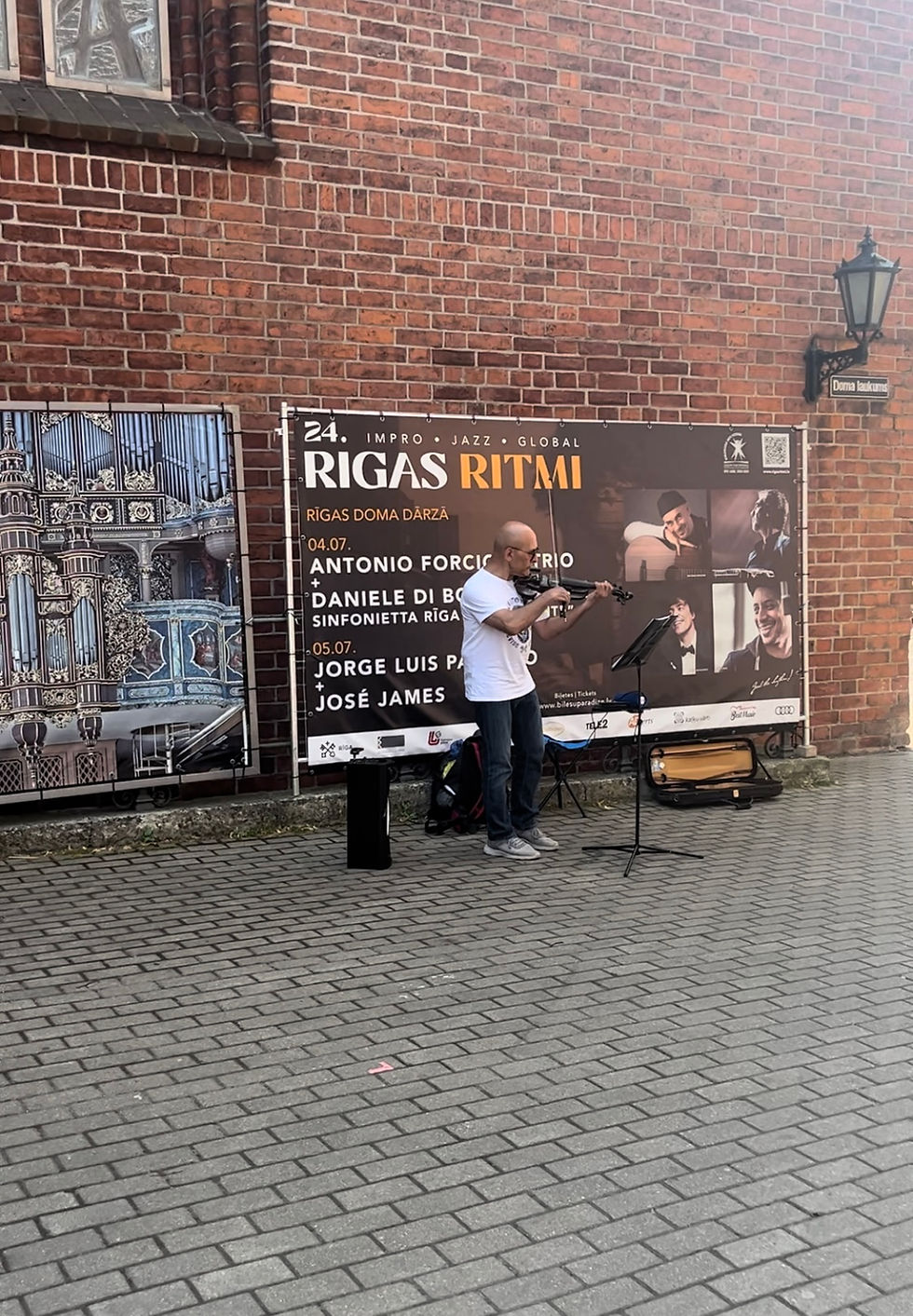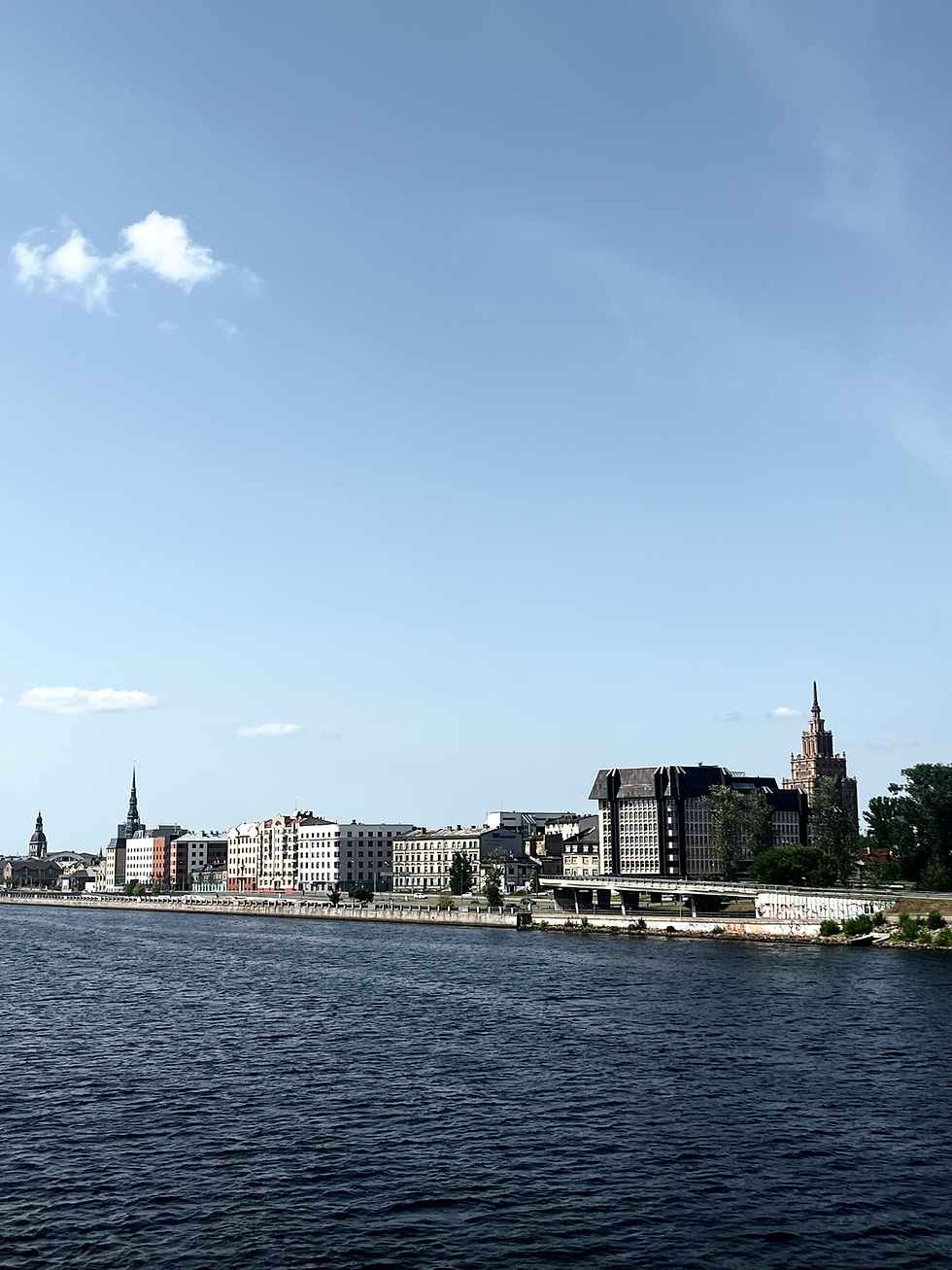Shy Hipsters (Days in Vilnius)
- charlsiedoan
- Jul 11, 2024
- 7 min read
Updated: Oct 27, 2024

In Baku, I found out that my walking tour guide had studied in Tartu, Estonia. “The Baltics are the land of shy hipsters,” he said. I found that description very accurate. It continues to be accurate in Lithuania.
I hate to say this and betray my beloved Tallinn, but it’s possible that Vilnius is my favorite Baltic capital. There are just so many unusual, quirky, hipstery things about Vilnius, this city that sits on a river close to the Belarussian border. The city is an art project, with a fuck-all, free-spirited attitude that the other Baltic countries share, I think the result of living freely under NATO largesse after escaping the Soviet Union.
A neighborhood that's just under a square mile, Užupis, declared itself an independent republic on April Fools’ Day in 1998, with an artist as president, a cat as vice president, and a constitution that enshrines everyone’s right to live by the river, to love, to die (but not necessarily), to believe or not believe. It also specifies that a cat is not obliged to love its owner but must help its owner in times of need. The constitution is printed in over thirty languages on mirrored panels that hang side-by-side on a brick wall. I spent about fifteen minutes just trying to identify each language. Google Translate failed me. Along with the basics like French, German, Arabic, and Chinese (and, of course, English and Lithuanian) you can read about cats’ rights in Irish Gaelic, Sanskrit, Korean, and Latin.

You can get your passport stamped at the border control/gift shop. I saw people do this and thought, huh, that might confuse border control agents in the future. So, my passport remained Užupis stamp-less. There are experimental public art installations, like a block of stone with a washing machine door on the front that encourages you to wash away bad thoughts, or a wall decorated with Lithuanian insults, or a very fat cat statue with a ring through its ear and a plaque telling you to live without fear.
There’s a little alley near the old town called “Literatu gatvė,” or “author street,” with over a hundred tiles embedded in the walls of the buildings. Each tile was designed by a different artist and inspired by a different author. I’d read about it and intended to go and find it, but then I stumbled upon the street by accident, which made me feel like a very cool, spontaneous person. Most of the authors are Lithuanian (except Simone de Beauvoir). I wrote my final paper on Beauvoir during my study abroad in Copenhagen. Ah, how everything connects.

And on the theme of tiles, in Cathedral Square there’s a reddish tile that stands out from the white palazzo that reads “Stebuklas,” which is Lithuanian for miracle. If you stand on the tile, face the church, and spin clockwise three times, whatever wish you then make will come true. I did this too, but obviously I’m not going to tell you my wish.
On August 23, 1989, the fiftieth anniversary of the treaty that divided eastern Europe between Nazi Germany and Soviet Russia, millions of Estonians, Latvians, and Lithuanians linked hands in a human chain that linked the three Baltic capitals. The chain ended (or began, depending on your perspective) on this tile.

I’ve been feeling very emotional at the end of this trip, and so I have enjoyed seeking out refuge in churches. If you’ve been reading my blog for a while, you know I like to do this. Churches are welcoming, quiet, cool, and always have places to sit (unless they’re Orthodox), and they’re the best non-alcoholic treatment for homesickness, at least for me. I’m not Catholic, but my brother is, so being around the liturgy reminds me of him, just like being on a golf course makes me feel close to my dad. So, I caught the tail end of a mass (in Lithuanian) in Vilnius Cathedral, on Cathedral Square.

Vilnius Cathedral is interesting too; it’s in a classical style, and by classical, I mean Greco-Roman, Parthenon-esque. Which is unusual for a Catholic church, since the heyday of antiquity predates the birth of Jesus. But, well, Catholicism in Lithuania is a little unusual. Lithuania was the last, the very last, part of Europe to become Christian, in the thirteenth century. Before that, like the rest of the Baltic people, Lithuanians were pagans. They worshiped the nature deities that they believed ruled the birch forests and sandy beaches. But they made up for their pagan years in tenfold: there are about a million churches in Vilnius in all styles, including the flame-red St. Anne’s church that Napoleon tried to raze to the ground. Many former Lithuanian leaders have been canonized. About 75% of the population today self-identifies as Roman Catholic, even if many of them are “Christmas and Easter” Christians. And, of course, there’s the Hill of Crosses.
Nobody really knows how the Hill of Crosses began. Lithuania lost its independence and became part of the Russian Empire in 1795. After a twenty-one year period of independence early in the twentieth century, Lithuania became part of the Soviet Union, which did not, as you should know by now, like religion very much. The crosses started appearing on the hill during Imperial occupation to commemorate resistance fighters, and then during Soviet times the hill became itself a symbol of resistance. The Russians tried everything to destroy the hill and stop the crosses from returning, but they were never successful. After Lithuania became independent from the Soviet Union (it was the first SSR to do so), Pope John Paul II visited the hill and called it a holy, special place.

The Hill of Crosses is not close to Vilnius; it’s in the Šiauliai region in the north of the country, but you should still go visit it if you’re ever in Lithuania. I found it a little unsettling just because of the sheer number of crosses (anything in that large a number—over a million—would be unsettling, plus most of the crosses are wooden), but I tried to remind myself that it’s not supposed to be creepy. It’s supposed to be hopeful. I thought about leaving a cross, but a) I didn’t have a cross and b) buying one would require me to walk back to the parking lot, which was really far away. So, I left an imaginary cross.
Now, while we’re on the topic of wooden things, let’s return to Vilnius and I’ll tell you about Šnipiškės. It’s a neighborhood of very old—sometimes two-centuries-old—wooden houses north of the river and north of the ultra-modern glass skyscrapers of new Vilnius. The roads are unpaved, some of the houses don’t have running water, and three houses have the same number (17). Essentially, during Soviet times, the Soviets were developing Vilnius but ran out of money by the time they reached Šnipiškės. So, they let it be, dividing each preexisting house into several apartments and shoving three or four families inside. Today, most houses still have multiple owners, and these owners will renovate only their part of the house. Each dwelling looks a little bit like a patchwork quilt. But turn south and you can see the skyscrapers looming over you. This was also the only place in Vilnius that I saw cats outside, which made me very happy.

A list of the best cures for homesickness (for me):
1. Sitting in a church
2. Seeing a cat (if it’s a kitten, this moves up to number one)
3. Watching golf on TV or being on a golf course
4. Beer
I took a bus from Vilnius to Warsaw. It was a nine-hour ride that I spent trying not to accidentally touch my seatmate: a large, tattooed man with a shirt that said “Belarus” in Cyrillic. I also ate cold cottage cheese pancakes (they’re not supposed to be eaten cold, folks) and watched Joker at the recommendation of my boyfriend and my brother (it is indeed an extremely sad movie).
But, anyway, I was waiting for the bus and this older couple came up to me and asked me for help with directions. The man was very frustrated and kept complaining—he shouldn’t have rented a car because parking was so expensive, there’s nothing to see in Vilnius, he couldn’t download a ride-share app because it would download in Lithuanian (I didn’t tell him that problem is easily solved with a VPN, which I also use to watch Modern Family and Law & Order). I tried to help them, but then I said “just give Vilnius a chance, it’s a really cool city!” Because it is!
Recommendations
Museums
The Palace of the Grand Dukes of Lithuania is Vilnius's biggest history museum, and although it isn't mind blowing, it provides some nice background.
The Church Heritage Museum, right across from St. Anne's, is a collection of church art and relics from Lithuania's short but passionate history as a Catholic country. Worth a visit if you are interested in religion.
Coffee
BREW Specialty Coffee: I went to this place twice; it's a little outside the old town but worth the walk. They have the best coffee in Vilnius plus laptop-friendly seating and air conditioning.
I also got coffee from Kitchen Coffee, right off Pilies gatve, a busy pedestrian street. It was good!
Food
For Lithuanian food, I went to Grey (also on Pilies gatve), but Etno Dvaras, a little bit further down the street, was also on my list.
Cozy had really good cottage cheese pancakes (a classic!)
I also had dinner at Rosehip Vegan Bistro, and it was nice to get have a meal consisting of vegetables that weren't beets!
How to Get Around
Vilnius is fairly walkable! I didn't end up using public buses because I walked everywhere, but you can use them if you need to. A few times I used Bolt for longer trips, which is incredibly cheap in the city.



Winding down on your trip. I can hear the sigh in your words. I'm so glad you've enjoyed your trip... and taught us so much about this area of the world! Thanks for taking us along. Safe travels home!
Love, Didi